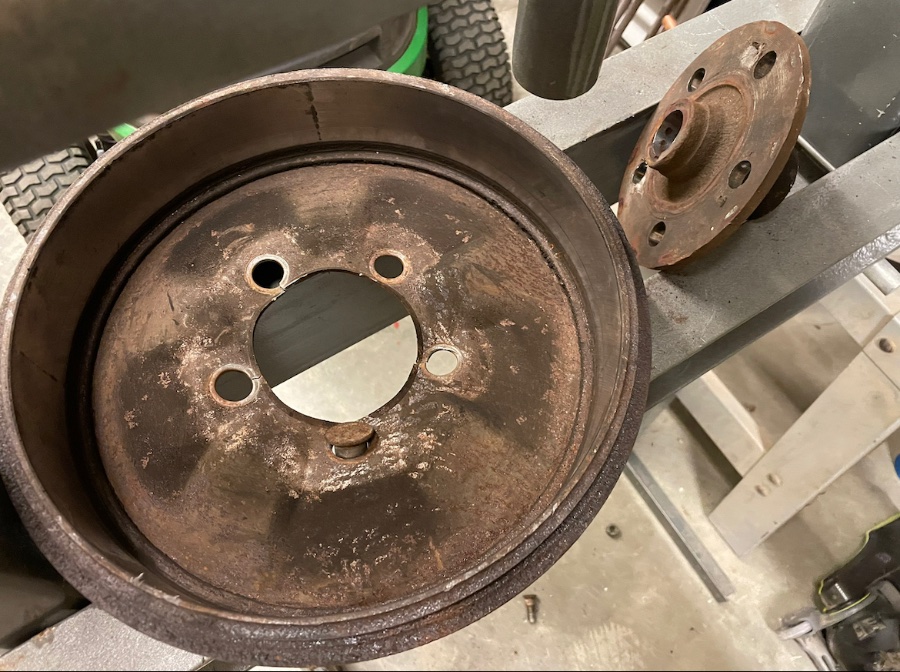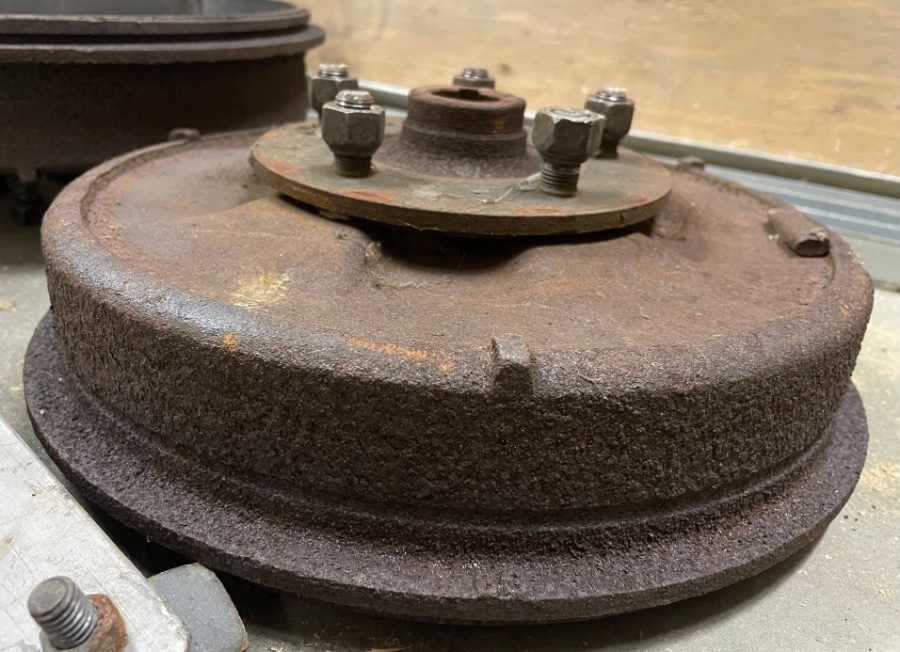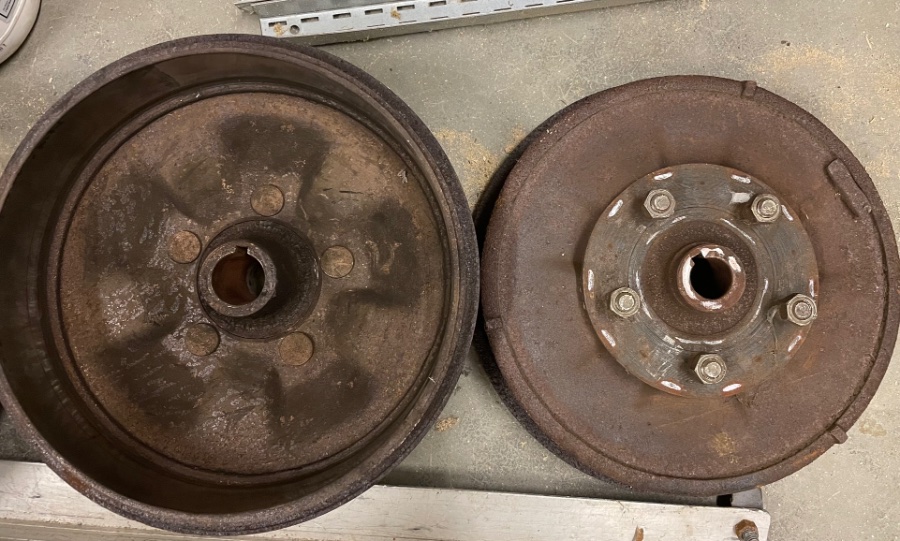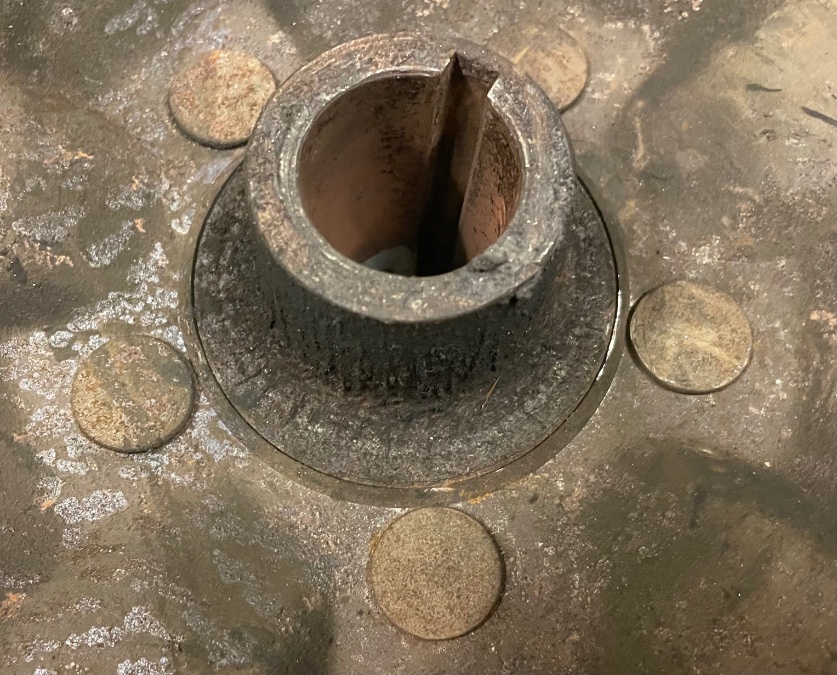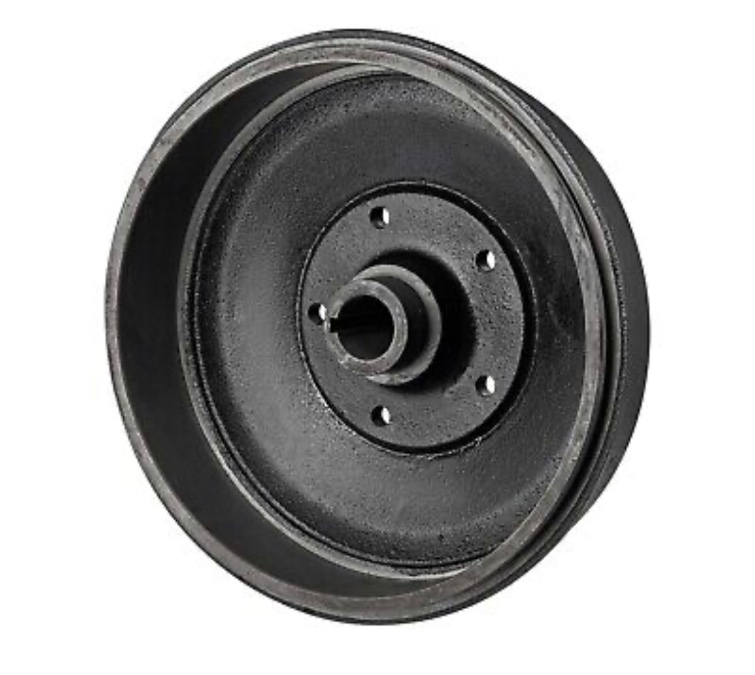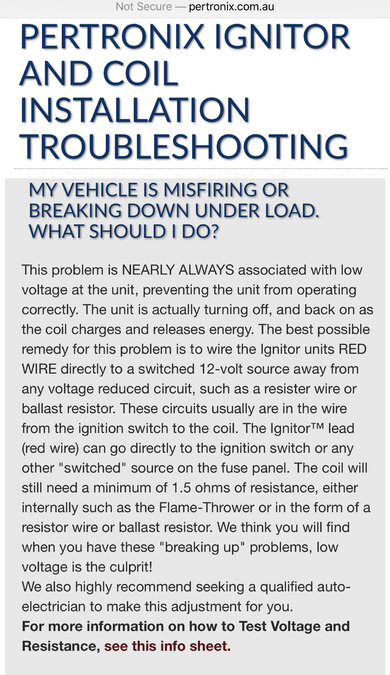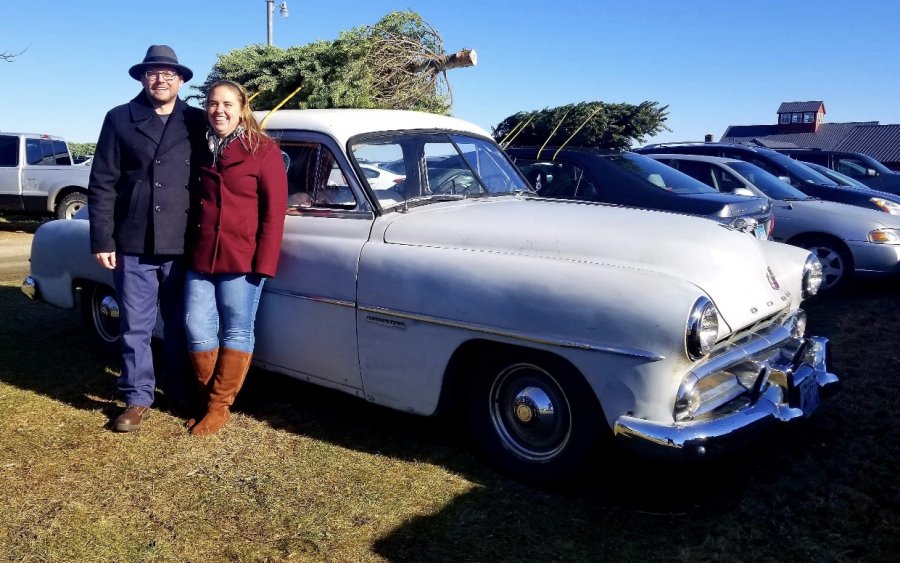-
Posts
132 -
Joined
-
Last visited
Content Type
Links Directory
Profiles
Articles
Forums
Downloads
Store
Gallery
Blogs
Events
Classifieds
Everything posted by 51_Meadowbrook
-
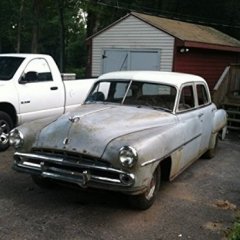
1951 Dodge Meadowbrook Brake Drum Interchange
51_Meadowbrook replied to 51_Meadowbrook's topic in P15-D24 Forum
Removing the studs revealed two pieces. Can I use a standard drum and the wheel studs into this hub or will the new drum be too shallow due to the indentations the older drum had which seem to push the drum back further? Do not use this picture as reference to the indentation, use the original one. Since I didn’t care about this drum since it couldn’t be turned I did not make sure to keep its structural shape when I was removing the studs. -

1951 Dodge Meadowbrook Brake Drum Interchange
51_Meadowbrook replied to 51_Meadowbrook's topic in P15-D24 Forum
Oh I didn’t even think of the threads. The drums and hubs are identical though, correct? -

1951 Dodge Meadowbrook Brake Drum Interchange
51_Meadowbrook replied to 51_Meadowbrook's topic in P15-D24 Forum
-

1951 Dodge Meadowbrook Brake Drum Interchange
51_Meadowbrook replied to 51_Meadowbrook's topic in P15-D24 Forum
-

1951 Dodge Meadowbrook Brake Drum Interchange
51_Meadowbrook replied to 51_Meadowbrook's topic in P15-D24 Forum
-

1951 Dodge Meadowbrook Brake Drum Interchange
51_Meadowbrook replied to 51_Meadowbrook's topic in P15-D24 Forum
The ones I took off are riveted as well. I thought about removing the rivets and attaching a new standard 11” drum on it but the drum turned said he wasn’t sure they would sit right since the original drums are recessed from the riveted section. -

1951 Dodge Meadowbrook Brake Drum Interchange
51_Meadowbrook replied to 51_Meadowbrook's topic in P15-D24 Forum
Why are the left and right different part numbers? Wouldn’t they be the same drum? What’s different about them? -
I don’t have an interchange book and it’s leading to my downfall. I thought I was just adjusting the brakes but I saw the front shoes full of brake fluid. So I took the front drums off and decided to have them turned. Since I was doing the front cylinders I decided to go to the back and rebuild them. I took the rear drums off and brought all four to get turned. The guy said did the front drums and said I need new bearings and races but wouldn’t do the rear. He said they were so out of round he couldn’t get them to come back. So now I’m stuck with $450 per drum unless I can find some used drums. My issue is I don’t know which cars used 11” drums with the hub attached to it. They are 11x2.25. It’s my understanding that Plymouth had this type but used 10” drums. Any ideas on which cars used that style brake drums and where I might find some used ones?
-
I had been enjoying my ‘51 Meadowbrook and took off from a red light. First gear was fine, second gear started making some rattling, then third gear was rattling so bad I thought I was going to lose my driveshaft. I got it home and checked and the driveshaft is fine. The u-joints seem solid. There is some play in the rear end. I topped off the differential and left the house and it started rattling bad in second too. After about a month of not driving it I took it out tonight around the block. Second gear sounded quieter but still rattling and third gear was rattling. I can’t seem to figure out what it is. It’s only when I accelerate. If I am coasting it doesn’t make the noise. If I push the clutch when coasting it doesn’t make the noise. But as soon as I press the accelerator it starts rattling again. There is no rattling in reverse. I see no signs of anything scraping. I checked the transmission mounts and they are tight. The transmission is a 3 speed manual fluid drive, not the gyro-magic electronic shift. Any suggestions?
-
That’s the problem, when I jump the terminals I get spark at the plugs. If I just turn the key to START the starter spins but no spark. I can have it soon all day by turning the key and get nowhere. But if I run a wire from the IGN to ST terminal it fires up immediately.
-
I have had quite a tough time with my '51 Meadowbrook over this past year. The latest of issues started with a faulty ignition switch; it would shut off if you hit a bump and would have to jiggle the key to get it to gain continuity again. It's a strange one that has three terminals, listed as ST, ACC, AM, and a central wire that is fixed to it under a metal sheathing that goes through the firewall and attaches to the horn relay. The switch I bought was from a '50 Coronet and has four terminals, listed ST, ACC, IGN, BATT. I'm not sure what the AM standards for but it had one wire attached to it. The ST had one wire attached to it. The ACC had the rest of the wires, such as the radio and heater motor, attached to it. So I connected the ST wire to the ST terminal of the new switch, the AM wire the ACC terminal, the set of wires from the ACC in the old switch to the IGN terminal in the new switch, and I ran a wire from the BATT terminal to the outside of the firewall to the horn relay. I did this based on position of the wires on the switch. Well that didn't work as it shot my Ammeter down to -50. So I found that the wire that is attached to the ACC wire had current in it and connected it to the BATT terminal. From there that left the wire on the ST, the wire on the BATT, the wire going to the horn relay on the ACC, and the set of wires on the IGN. I turned the key and the starter turned and turned but would not fire up. I found that the only way it will fire up, and it fires up immediately, is if I turn the key to ON and connect a wire from the IGN to the ST. I can't understand why it will not fire is I turn the to the START position. I also found out that if the engine is running and I turn the key from ON to ACC the engine continues to run. What am I messing up, or is this switch faulty as well? And through my playing with this switch I fried the LED flasher relay so I need to replace it.
-

1951 Meadowbrook dim directionals
51_Meadowbrook replied to 51_Meadowbrook's topic in Technical Archives
Being unable to make the lights any brighter than they were, which probably was right for the car, I converted them to LED. I picked a bulb that was about the same brightness for both dim and bright filaments. The LED is very distinct on the bright light. You can tell I’m hitting the brake and when the directional is on. And the bonus is that it barely draws on the battery. Since I bought the taillights I bought the front directionals and the flasher. They work beautifully now. -
This may not be the right spot for this post but here goes. It’s time for me to replace the tires on my cars and the old debate pops up. Which tire size should I get? My ‘51 Dodge Meadowbrook originally had 7.10-15 bias tires on it. The guy I bought it from out 225/75/15 on it. So when I changed them I put them on too. As I’m looking at different conversion charts they are saying 215/75/15 or 225/70/15. Being a little green on tires I’m not sure exactly what makes one tire better or worse than the other. I understand the fundamentals of the tire sizes but not necessarily the functional difference between them. Anyone willing to shed some light and their thoughts on this would be great. Does one provide a better comfort when riding down the road than the other?
-
-
Vacuum leaks are a monster. They can cause erratic issues. I may be way off but I would think that if the vacuum is bouncing all over it would be pulling the distributor really strong and letting it go back to idle position and bounce back and forth between.
-
They looked pretty great. With the destroyed crankshaft from the spun bearing I am going to use the crankshaft from the parts car engine. But I need to understand these cylinders and what I should get them to measure like so I don’t waste my time with rebuilding the engine and still have low compression and oil consumption.
-
Thanks for responding. Prior to me having knowledge of clearances and measurements I had rebuilt the engine, well more just assembled it, with standard rings and pistons. I had low compression and oil consumption, blue smoke in the drivers side exhaust. A little history of the engine, it was removed in 1976 due to high oil consumption. When I got it, it was in the trunk and all of the parts were scattered so I cleaned it, bought a rebuild kit with standard rings and bearings. It ran pretty well for about 500 miles, with the exception of oil loss and overheating. I had low compression but the engine didn’t act up. Until a couple weeks ago when I got a rod knock because it ate through one of the bearings. I took the engine out and now I have to figure out what to do with the cylinders before I put it back together.
-
I know this isn’t exactly in the scope of Mopar forums but the knowledge I learn with this will help me when i rebuild my ‘51 Dodge Meadowbrook. Using a dial bore gauge I got my measurements for the ‘52 Cadillac. I set it to be within factory standard specs and this is what I came up with. I can see out or round and I can see taper from the measurements. Is that all it was that caused my low compression and oil consumption? I’m assuming I need to bore these to .010 over now. Knowledge me up on this because this part is new to me. T - Top (about an inch down) M - Middle B - Bottom (about 1.5-2 inches from the bottom) H - Measuring rod was horizontal V - Measuring rod was Vertical
-
My ‘51 Dodge Meadowbrook has very dim rear turn signals when the tail lights are on. They are almost unrecognizable. Were these directionals dim from the factory or were they clear and recognizable like today’s turn signals? When the taillights are not on you can see the turn signal clearly but when the taillights are on the turn signal doesn’t make a bright enough light for the signal to be obvious. Unless you are really focusing on it it doesn’t even look like it is on. I know that some people are suggesting LEDs and I’m not sure which to go with since this is a positive ground system. Any suggestions on the current dim situation would be appreciated. Any ideas on the correct LED bulb I would need is helpful too.
-
John, I know we are off my question already of the temp gauge being at hot but it’s my first time back on here. I understand that engines heat up as they sit. I have the same engine and same car and when my car shuts off it goes up only a slight bit. It does not go to the HOT point. The engine is not suppose to be at an overheat point when it shuts off. That would mean any time you shut the car off and turn it back on it is overheating and that’s not good for the engine. My needle is a little before the dot on the temperature gauge when it is at normal operating temperature of 180 degrees. Then when it is shut off it goes to the dot, which is 3/4 of the way up the gauge. I know your engine is rebuilt so I assume you bathed the engine when it was out to clean it up. I haven’t done that yet but I essentially did the same thing by using the Evaporust Thermocure designed for cleaning the cooling system. If the general consensus is that the needle being at the HOT level is normal and ok then I won’t argue the point. It just seems odd based on my experience and I’d hate for your engine to be silently in trouble.
-
John, why is the temp gauge pegged after shut off?
-
-
John you use a 180 thermostat, do you use that year round? Do I remember you saying something about waterless coolant?
-
John I hope you took the family out to get the tree in the old car. It’s a lot of fun seeing everyone stare and smile as you drive by.
-
I don’t have a picture for you but mine goes to the bolt directly behind the thermostat.housing.


